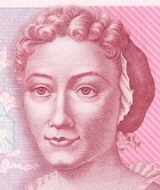
Maria Sibylla Merian
Encyclopedia
Maria Sibylla Merian was a naturalist and scientific illustrator who studied plants
and insects and made detailed paintings about them. Her detailed observations and documentation of the metamorphosis of the butterfly make her a significant, albeit not well known, contributor to entomology
.
, Germany
, into the family of Swiss engraver and publisher Matthäus Merian
the Elder. Her father died three years later and in 1651 her mother married still life
painter Jacob Marrel
. Marrel encouraged Merian to draw and paint. At the age of 13 she painted her first images of insects and plants from specimens she had captured.
In 1665 Merian married Marrell's apprentice, Johann Andreas Graff. Two years later she had her first child, Johanna Helena, and the family moved to Nuremberg
. While living there, Maria Sibylla continued painting, working on parchment and linens, and creating designs for embroidery patterns. She took on many students, which helped the family financially, and increased their social standing. This provided her with access to the finest gardens, maintained by the wealthy and elite.
In those gardens, Merian began studying insects, particularly the lifecycle of caterpillars and butterflies. The scholars of the time believed that insects came from "spontaneous generation
of rotting mud", an Aristotelian
idea held in spite of—or perhaps because of—the teachings of the Catholic Church. Although St Thomas Aquinas concluded that spontaneous generation of insects was the work of the Devil, Pope Innocent V in the thirteenth century had declared that belief in spontaneous generation went against Church teachings, since all life was created in the first days of Creation chronicled in Genesis; however, the Greek tradition prevailed in the scientific community. Against the prevailing opinion, Merian studied what actually happened in the transformation of caterpillars into butterflies. She took note of the transformations, along with the details of the chrysalises and plants that they used to feed themselves, and illustrated all the stages of their development in her sketch book.
This book of sketches turned into her first book, the first edition of which was sold in 1675 at the age of 28 under the title Neues Blumenbuch -- New book of flowers. In 1678 her second daughter, Dorotha Maria (wife of painter Georg Gsell
), was born, and one year later she published another book called Der Raupen wunderbare Verwandlung und sonderbare Blumennahrung -- The Caterpillar, Marvelous Transformation and Strange Floral Food. In this book she presented the stages of development of different species of butterflies along with the plants on which they fed.
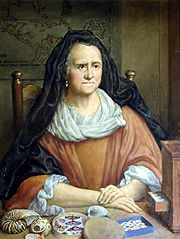 In 1681 Jacob Marrell died and the Graff family returned to Frankfurt in 1683 to handle the estate, including the house, art work, library and financial issues left unresolved at the time of his death. A lawsuit was filed by the fractured factions of the families. Upon its resolution in 1685, at the age of 38, Merian left her husband. Accompanied by her mother and daughters, she moved to the Labadist
In 1681 Jacob Marrell died and the Graff family returned to Frankfurt in 1683 to handle the estate, including the house, art work, library and financial issues left unresolved at the time of his death. A lawsuit was filed by the fractured factions of the families. Upon its resolution in 1685, at the age of 38, Merian left her husband. Accompanied by her mother and daughters, she moved to the Labadist
religious commune in Friesland
, whose practices included celibacy. The family moved into a home owned by Cornelis van Sommelsdijk, the governor of Surinam. Here she studied the world of South American tropical flora and fauna.
Five years later her mother died and she moved to Amsterdam
. Merian's husband divorced her two years later, in 1692. In Amsterdam Merian and her work attracted the attention of various contemporary scientists. Her older daughter, Johanna Helena, married merchant Jacob Herolt and moved with him to Surinam, which was at that time a recently acquired Dutch colony.
In 1699 the city of Amsterdam sponsored Merian to travel to Surinam along with her younger daughter, Dorothea Maria. Before departing, she wrote:
Merian worked in Surinam (which included what later became known as the French, Dutch and British Guianas) for two years, travelling around the colony and sketching local animals and plants. She also criticized the way Dutch planters treated Amerindian and black slave
s. She recorded local native names for the plants and described local uses. In 1701 malaria
forced her to return to Netherlands.
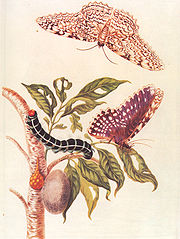 Back in the Netherlands she sold specimens she had collected and published a collection of engravings about the life in Surinam. In 1705 she published a book Metamorphosis Insectorum Surinamensium about the insects of Surinam. She used Linnaeus'classification of natural species.
Back in the Netherlands she sold specimens she had collected and published a collection of engravings about the life in Surinam. In 1705 she published a book Metamorphosis Insectorum Surinamensium about the insects of Surinam. She used Linnaeus'classification of natural species.
In 1715 Merian suffered a stroke and was partially paralysed. She continued her work but the disease probably affected her ability to work; a later registry lists her as a pauper.
Maria Sibylla Merian died in Amsterdam on January 13, 1717. Her daughter Dorothea published Erucarum Ortus Alimentum et Paradoxa Metamorphosis, a collection of her mother's work, posthumously.
In the last years of the 20th century, the work of Merian has been rediscovered and recognised. For example, her portrait was printed on the 500 DM note before Germany converted to the euro
. Her portrait has also appeared on a 0.40 DM stamp, released on September 17, 1987, and many schools are named after her. In 2005, a modern research vessel
named Maria S. Merian
was launched at Warnemünde
, Germany.
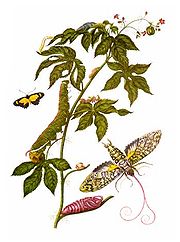 Merian worked as a botanic artist. She published three collections of engravings of plants in 1675, 1677 and 1680. Afterwards she studied insects, keeping her own live specimens, and made drawings showing insect metamorphosis, in which all life stages of the insect (egg, larva, pupa, and adult) were depicted in the same drawing. In her time, it was very unusual that someone would be genuinely interested in insects, which had a bad reputation and were colloquially called "beasts of the devil
Merian worked as a botanic artist. She published three collections of engravings of plants in 1675, 1677 and 1680. Afterwards she studied insects, keeping her own live specimens, and made drawings showing insect metamorphosis, in which all life stages of the insect (egg, larva, pupa, and adult) were depicted in the same drawing. In her time, it was very unusual that someone would be genuinely interested in insects, which had a bad reputation and were colloquially called "beasts of the devil
." As a consequence of their reputation, the metamorphosis of these animals was largely unknown. Merian described the life cycles of 186 insect species, amassing evidence that contradicted the contemporary notion that insects were "born of mud" by spontaneous generation
.
Moreover, although certain scholars were aware of the process of metamorphosis from the caterpillar to the butterfly, the majority of people did not understand the process.
The work that Anna Maria Sibylla Merian published, Der Raupen wunderbare Verwandlung und sonderbare Blumennahrung -- The Caterpillars' Marvelous Transformation and Strange Floral Food, was very popular in certain sections of high society
as a result of being published in the vernacular
. However, it is notable that her work was largely ignored by scientists of the time because the official language of science was still Latin
.
Merian also described many other details of the evolution and lifecycle of the insects she observed. She could, for example, show that each stage of the change from caterpillar to butterfly depended on a small number of plants for its nourishment. As a consequence the eggs were laid near these plants.
Her work places her among one of the first naturalists to have observed insects directly. This approach gave her much more insight into their lives and was contrary to the way that most scientists worked at the time.
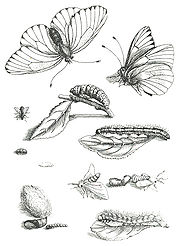 The pursuit of her work in Suriname
The pursuit of her work in Suriname
was an unusual endeavour, especially for a woman. In general, men received royal or government funding to travel in the colonies to find new species of plants and animals, make collections and to work there, or to settle. Scientific expeditions at this period of time were not common, and Merian's unofficial, self-funded expedition raised many eyebrows. She succeeded, however, in discovering a whole range of previously unknown animals and plants in the interior of Surinam. Merian spent time studying and classifying her findings and described them in great detail. Her classification of butterflies and moths is still relevant today. She used Native American
names to refer to the plants, which became used in Europe:
Her drawings of plants, frogs, snakes, spiders, iguanas and tropical beetles are still collected today by amateurs all over the world. The German word Vogelspinne—mygalomorphae
, translated literally as bird spider—probably has its origins in an engraving by Maria Sibylla Merian. The engraving, created from sketches drawn in Surinam, shows a large spider who had just captured a bird. In the same engraving and accompanying text Merian was the first European to describe both army ants and leaf cutter ants and their effect on other organisms .
Botany
Botany, plant science, or plant biology is a branch of biology that involves the scientific study of plant life. Traditionally, botany also included the study of fungi, algae and viruses...
and insects and made detailed paintings about them. Her detailed observations and documentation of the metamorphosis of the butterfly make her a significant, albeit not well known, contributor to entomology
Entomology
Entomology is the scientific study of insects, a branch of arthropodology...
.
Biography
Maria Sibylla Merian was born on April 2, 1647 in FrankfurtFrankfurt
Frankfurt am Main , commonly known simply as Frankfurt, is the largest city in the German state of Hesse and the fifth-largest city in Germany, with a 2010 population of 688,249. The urban area had an estimated population of 2,300,000 in 2010...
, Germany
Germany
Germany , officially the Federal Republic of Germany , is a federal parliamentary republic in Europe. The country consists of 16 states while the capital and largest city is Berlin. Germany covers an area of 357,021 km2 and has a largely temperate seasonal climate...
, into the family of Swiss engraver and publisher Matthäus Merian
Matthäus Merian
Matthäus Merian der Ältere was a Swiss-born engraver who worked in Frankfurt for most of his career, where he also ran a publishing house.-Early life and marriage:...
the Elder. Her father died three years later and in 1651 her mother married still life
Still life
A still life is a work of art depicting mostly inanimate subject matter, typically commonplace objects which may be either natural or man-made...
painter Jacob Marrel
Jacob Marrel
Jacob Marrel was a German still life painter active in Utrecht during the Dutch Golden Age.-Biography:Jacob Marrel was born in Frankenthal. He moved with his family in 1624 to Frankfurt, where he became a student of Georg Flegel in 1627...
. Marrel encouraged Merian to draw and paint. At the age of 13 she painted her first images of insects and plants from specimens she had captured.
- "In my youth, I spent my time investigating insects. At the beginning, I started with silk worms in my home town of Frankfurt. I realised that other caterpillars produced beautiful butterflies or moths, and that silk worms did the same. This led me to collect all the caterpillars I could find in order to see how they changed". (foreword from Metamorphosis insectorum Surinamensium — Metamorphosis of the Insects of Surinam)
In 1665 Merian married Marrell's apprentice, Johann Andreas Graff. Two years later she had her first child, Johanna Helena, and the family moved to Nuremberg
Nuremberg
Nuremberg[p] is a city in the German state of Bavaria, in the administrative region of Middle Franconia. Situated on the Pegnitz river and the Rhine–Main–Danube Canal, it is located about north of Munich and is Franconia's largest city. The population is 505,664...
. While living there, Maria Sibylla continued painting, working on parchment and linens, and creating designs for embroidery patterns. She took on many students, which helped the family financially, and increased their social standing. This provided her with access to the finest gardens, maintained by the wealthy and elite.
In those gardens, Merian began studying insects, particularly the lifecycle of caterpillars and butterflies. The scholars of the time believed that insects came from "spontaneous generation
Spontaneous generation
Spontaneous generation or Equivocal generation is an obsolete principle regarding the origin of life from inanimate matter, which held that this process was a commonplace and everyday occurrence, as distinguished from univocal generation, or reproduction from parent...
of rotting mud", an Aristotelian
Aristotle
Aristotle was a Greek philosopher and polymath, a student of Plato and teacher of Alexander the Great. His writings cover many subjects, including physics, metaphysics, poetry, theater, music, logic, rhetoric, linguistics, politics, government, ethics, biology, and zoology...
idea held in spite of—or perhaps because of—the teachings of the Catholic Church. Although St Thomas Aquinas concluded that spontaneous generation of insects was the work of the Devil, Pope Innocent V in the thirteenth century had declared that belief in spontaneous generation went against Church teachings, since all life was created in the first days of Creation chronicled in Genesis; however, the Greek tradition prevailed in the scientific community. Against the prevailing opinion, Merian studied what actually happened in the transformation of caterpillars into butterflies. She took note of the transformations, along with the details of the chrysalises and plants that they used to feed themselves, and illustrated all the stages of their development in her sketch book.
This book of sketches turned into her first book, the first edition of which was sold in 1675 at the age of 28 under the title Neues Blumenbuch -- New book of flowers. In 1678 her second daughter, Dorotha Maria (wife of painter Georg Gsell
Georg Gsell
Georg Gsell was a Swiss Baroque painter, art consultant and art dealer. Was recruited by Peter the Great in 1716 and went to Russia...
), was born, and one year later she published another book called Der Raupen wunderbare Verwandlung und sonderbare Blumennahrung -- The Caterpillar, Marvelous Transformation and Strange Floral Food. In this book she presented the stages of development of different species of butterflies along with the plants on which they fed.

Labadists
The Labadists were a 17th century Protestant religious community movement founded by Jean de Labadie , a French pietist. The movement derived its name from that of its founder.-Jean de Labadie’s life:...
religious commune in Friesland
Friesland
Friesland is a province in the north of the Netherlands and part of the ancient region of Frisia.Until the end of 1996, the province bore Friesland as its official name. In 1997 this Dutch name lost its official status to the Frisian Fryslân...
, whose practices included celibacy. The family moved into a home owned by Cornelis van Sommelsdijk, the governor of Surinam. Here she studied the world of South American tropical flora and fauna.
Five years later her mother died and she moved to Amsterdam
Amsterdam
Amsterdam is the largest city and the capital of the Netherlands. The current position of Amsterdam as capital city of the Kingdom of the Netherlands is governed by the constitution of August 24, 1815 and its successors. Amsterdam has a population of 783,364 within city limits, an urban population...
. Merian's husband divorced her two years later, in 1692. In Amsterdam Merian and her work attracted the attention of various contemporary scientists. Her older daughter, Johanna Helena, married merchant Jacob Herolt and moved with him to Surinam, which was at that time a recently acquired Dutch colony.
In 1699 the city of Amsterdam sponsored Merian to travel to Surinam along with her younger daughter, Dorothea Maria. Before departing, she wrote:
- In Holland, I noted with much astonishment what beautiful animals came from the East and West Indies. I was blessed with having been able to look at both the expensive collection of Doctor Nicolaas WitsenNicolaes WitsenNicolaas or Nicolaes Witsen was mayor of Amsterdam thirteen times, between 1682-1706. In 1693 he became administrator of the VOC. In 1689 he was extraordinary-ambassador to the English court, and became Fellow of the Royal Society. In his free time he was cartographer, maritime writer, and an...
, mayor of Amsterdam and director of the East Indies society, and that of Mr. Jonas Witsen, secretary of Amsterdam. Moreover I also saw the collections of Mr. Fredericus Ruysch, doctor of medicine and professor of anatomy and botany, Mr. Livinus VincentLevinus VincentLevinus Vincent was a rich Dutch damask merchant of the Anabaptist faith. He collected naturalia and artificialia -...
, and many other people. In these collections I had found innumerable other insects, but finally if here their origin and their reproduction is unknown, it begs the question as to how they transform, starting from caterpillars and chrysalises and so on. All this has, at the same time, led me to undertake a long dreamed of journey to Suriname. (foreword in Metamorphosis insectorum Surinamensium)
Merian worked in Surinam (which included what later became known as the French, Dutch and British Guianas) for two years, travelling around the colony and sketching local animals and plants. She also criticized the way Dutch planters treated Amerindian and black slave
Slavery
Slavery is a system under which people are treated as property to be bought and sold, and are forced to work. Slaves can be held against their will from the time of their capture, purchase or birth, and deprived of the right to leave, to refuse to work, or to demand compensation...
s. She recorded local native names for the plants and described local uses. In 1701 malaria
Malaria
Malaria is a mosquito-borne infectious disease of humans and other animals caused by eukaryotic protists of the genus Plasmodium. The disease results from the multiplication of Plasmodium parasites within red blood cells, causing symptoms that typically include fever and headache, in severe cases...
forced her to return to Netherlands.

In 1715 Merian suffered a stroke and was partially paralysed. She continued her work but the disease probably affected her ability to work; a later registry lists her as a pauper.
Maria Sibylla Merian died in Amsterdam on January 13, 1717. Her daughter Dorothea published Erucarum Ortus Alimentum et Paradoxa Metamorphosis, a collection of her mother's work, posthumously.
In the last years of the 20th century, the work of Merian has been rediscovered and recognised. For example, her portrait was printed on the 500 DM note before Germany converted to the euro
Euro
The euro is the official currency of the eurozone: 17 of the 27 member states of the European Union. It is also the currency used by the Institutions of the European Union. The eurozone consists of Austria, Belgium, Cyprus, Estonia, Finland, France, Germany, Greece, Ireland, Italy, Luxembourg,...
. Her portrait has also appeared on a 0.40 DM stamp, released on September 17, 1987, and many schools are named after her. In 2005, a modern research vessel
Research vessel
A research vessel is a ship designed and equipped to carry out research at sea. Research vessels carry out a number of roles. Some of these roles can be combined into a single vessel, others require a dedicated vessel...
named Maria S. Merian
RV Maria S. Merian
thumb|right|300px|RV Maria S. MerianRV Maria S. Merian is Germany's most modern research vessel, named after the naturalist and illustrator Maria Sybilla Merian...
was launched at Warnemünde
Warnemünde
Warnemünde is a sea resort and northmost district of Rostock in Mecklenburg-Vorpommern, situated on the Baltic Sea in the northeast of Germany at the estuary of the river Warnow.- History :...
, Germany.
Her work

Beelzebub
Beelzebub -Religious meaning:Ba‘al Zəbûb is variously understood to mean "lord of flies", or "lord of the dwelling". Originally the name of a Philistine god, Beelzebub is also identified in the New Testament as Satan, the "prince of the demons". In Arabic the name is retained as Ba‘al dhubaab /...
." As a consequence of their reputation, the metamorphosis of these animals was largely unknown. Merian described the life cycles of 186 insect species, amassing evidence that contradicted the contemporary notion that insects were "born of mud" by spontaneous generation
Spontaneous generation
Spontaneous generation or Equivocal generation is an obsolete principle regarding the origin of life from inanimate matter, which held that this process was a commonplace and everyday occurrence, as distinguished from univocal generation, or reproduction from parent...
.
Moreover, although certain scholars were aware of the process of metamorphosis from the caterpillar to the butterfly, the majority of people did not understand the process.
The work that Anna Maria Sibylla Merian published, Der Raupen wunderbare Verwandlung und sonderbare Blumennahrung -- The Caterpillars' Marvelous Transformation and Strange Floral Food, was very popular in certain sections of high society
Aristocracy
Aristocracy , is a form of government in which a few elite citizens rule. The term derives from the Greek aristokratia, meaning "rule of the best". In origin in Ancient Greece, it was conceived of as rule by the best qualified citizens, and contrasted with monarchy...
as a result of being published in the vernacular
German language
German is a West Germanic language, related to and classified alongside English and Dutch. With an estimated 90 – 98 million native speakers, German is one of the world's major languages and is the most widely-spoken first language in the European Union....
. However, it is notable that her work was largely ignored by scientists of the time because the official language of science was still Latin
Latin
Latin is an Italic language originally spoken in Latium and Ancient Rome. It, along with most European languages, is a descendant of the ancient Proto-Indo-European language. Although it is considered a dead language, a number of scholars and members of the Christian clergy speak it fluently, and...
.
Merian also described many other details of the evolution and lifecycle of the insects she observed. She could, for example, show that each stage of the change from caterpillar to butterfly depended on a small number of plants for its nourishment. As a consequence the eggs were laid near these plants.
Her work places her among one of the first naturalists to have observed insects directly. This approach gave her much more insight into their lives and was contrary to the way that most scientists worked at the time.

Suriname
Suriname , officially the Republic of Suriname , is a country in northern South America. It borders French Guiana to the east, Guyana to the west, Brazil to the south, and on the north by the Atlantic Ocean. Suriname was a former colony of the British and of the Dutch, and was previously known as...
was an unusual endeavour, especially for a woman. In general, men received royal or government funding to travel in the colonies to find new species of plants and animals, make collections and to work there, or to settle. Scientific expeditions at this period of time were not common, and Merian's unofficial, self-funded expedition raised many eyebrows. She succeeded, however, in discovering a whole range of previously unknown animals and plants in the interior of Surinam. Merian spent time studying and classifying her findings and described them in great detail. Her classification of butterflies and moths is still relevant today. She used Native American
Indigenous peoples of the Americas
The indigenous peoples of the Americas are the pre-Columbian inhabitants of North and South America, their descendants and other ethnic groups who are identified with those peoples. Indigenous peoples are known in Canada as Aboriginal peoples, and in the United States as Native Americans...
names to refer to the plants, which became used in Europe:
- "I created the first classification for all the insects which had chrysalises, the daytime butterflies and the nighttime moths. The second classification is that of the maggots, worms, flies and bees. I retained the indigenous names of the plants, because they were still in use in America by both the locals and the Indians". (in the foreword of Metamorphosis insectorum Surinamensium).
Her drawings of plants, frogs, snakes, spiders, iguanas and tropical beetles are still collected today by amateurs all over the world. The German word Vogelspinne—mygalomorphae
Mygalomorphae
The Mygalomorphae, , are an infraorder of spiders. The latter name comes from the orientation of the fangs which point straight down and do not cross each other .-Description:...
, translated literally as bird spider—probably has its origins in an engraving by Maria Sibylla Merian. The engraving, created from sketches drawn in Surinam, shows a large spider who had just captured a bird. In the same engraving and accompanying text Merian was the first European to describe both army ants and leaf cutter ants and their effect on other organisms .
See also
- Women artistsWomen artistsWomen artists have been involved in making art in most times and places. Often certain certain media are associated with women, particularly textile arts; however, these gender roles in art change in different cultures and communities...
- RV Maria S. MerianRV Maria S. Merianthumb|right|300px|RV Maria S. MerianRV Maria S. Merian is Germany's most modern research vessel, named after the naturalist and illustrator Maria Sybilla Merian...
is Germany's most modern research vessel, named after Merian.
Further reading
- Davis, Natalie Zemon. Women on the Margins: Three Seventeenth-Century Lives. Cambridge: Harvard UP, 1995, pp. 140-202.
- Reidell, Heidi. "A Study of Metamorphosis." Américas Magazine. March–April 2008, pp. 28–35.
External links
- Metamorphosis Insectorum Surinamensium:
- Metamorphosis insectorum Surinamensium images
- Online version of Metamorphosis insectorum Surinamensium from GDZ
- Metamorphosis Insectorum Surinamensium (1705) - digital facsimile, Linda Hall Library
- Other
- German Language Site on Maria with Music and a lot of images
- Online version of Over de voortteeling en wonderbaerlyke veranderingen der Surinaemsche Insecten from GDZ
- Online version of Erucarum ortus, alimentum et paradoxa metamorphosis from GDZ
- Online version of De Europische Insecten
- The Flowering Genius of Maria Sibylla Merian Ingrid Rowland on Merian from The New York Review of BooksThe New York Review of BooksThe New York Review of Books is a fortnightly magazine with articles on literature, culture and current affairs. Published in New York City, it takes as its point of departure that the discussion of important books is itself an indispensable literary activity...
- Der Raupen wunderbare Verwandlung ...images

